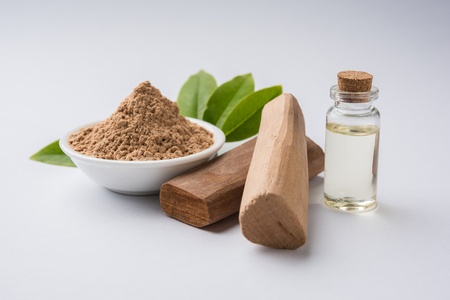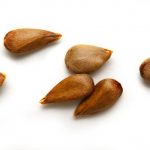
Sandalwood is a slow-growing, semi-parasitic tree which constitutes the plant genus, Santalum. It is found growing as native throughout to South Asia, Oceania, and the islands of the South Pacific.
It is highly prized for its long-lasting woody, sweet-smelling fragrance which is used as a base in perfumes, male products and skin cosmetics, soaps, flavourings, and traditional Japanese incense. It blends extremely well with other essential oils to provide bass notes.
Appearance Of Sandalwood
A tall, relatively spindly tree which can grow up to 33 feet with glossy green elliptical leaves. It takes up to 60 years to mature.
The main sandalwood grown in India is Santalum album L., and is considered a “true” sandalwood, lending a rich, sweet, creamy, earthy, wood aroma to any oil preparations. Unfortunately, due to high demand and the length of time it takes to grow, Indian sandalwood has suffered from over-harvesting and is now listed as vulnerable if not endangered according to the IUCN Red List of Threatened Species.
Other species now considered suitable for use include the Australian ‘version’ sandalwood, Santalum spicatum. This has a slightly different aroma profile of smooth, woody, earthy, and hinting of balsam.
Uses Of Sandalwood Essential Oil
Traditionally, the oil has been a part of the religious tradition in India, Japan and other South-Eastern countries. The tree itself is considered holy and used for various religious ceremonies, including decorating for weddings or for the birth of a baby. Look out for other essential oils including frankincense and cedarwood as complementary oils in their aroma complexity.
Components
The two main constituents (total of 90 per cent of the essential oil) that contribute most to the sandalwood aroma are the sesquiterpenic alcohols, alpha-santalol (50-60 per cent) and beta-santalol (20-25 per cent), and are present in sandalwood oil (Braun et al., 2007). While beta-santalol gives sandalwood oil its powerful fragrance, alpha-santalol is primarily therapeutic with many healing, protective, and enigmatic properties.
The composition of the oil will depend on the species, where it is grown and the age. Quality of oil also depends on harvesting methods and extraction process used.
Legal Disclaimer Concerning Products On This Web-Site
The products and the information provided about specific products on or through this site have not been evaluated by the United States Food and Drug Administration or by any other national regulatory body and are not intended to diagnose, treat, cure or prevent disease. The information provided on this site is for informational purposes only and is not intended as a substitute for advice from your physician/doctor or other health care professional or any information contained on or in any product label or packaging. You should not use the information on this site for diagnosis or treatment of any health problems or for prescription of any medication or other treatment. You should consult with a healthcare professional before starting any diet, exercise or supplementation program, before taking any medication or if you suspect you might have a health problem.
References
Braun, N.A., Butaud, J.-F., Bianchini, J.-P., Kohlenberg, B., Hammerschmidt, F.-J., Meier, M., Raharivelomanana, P. (2007) Nat. Prod. Commun. 2007, 2, pp. 695, and references cited therein.


Beautiful and gorgeous smell. I have been adding it to Indian soap nuts so that the washing comes out smelling really pleasant and exotic. I also dabble a bit in aromatherapy and I find this a great one for the men. You don’t need a lot for it to work properly. My only issue with it is when it smells slightly overpowering but then most men do on a lot of occasions.